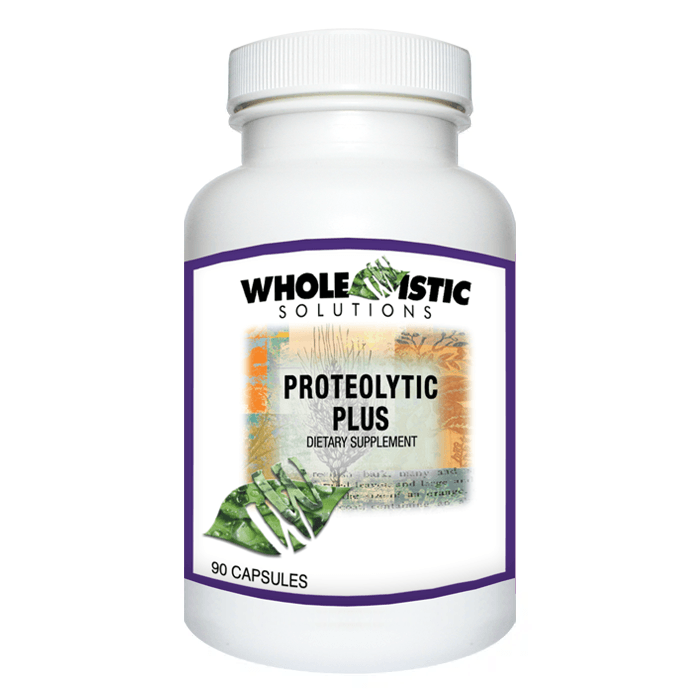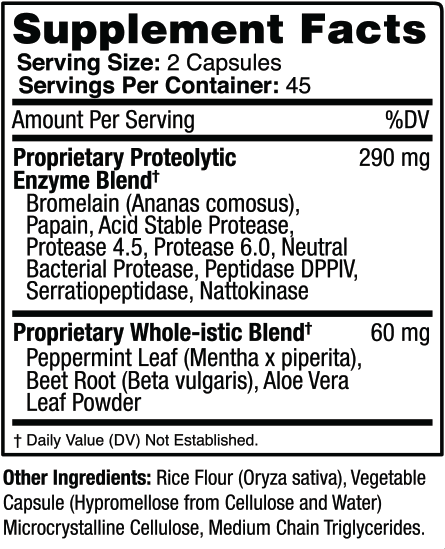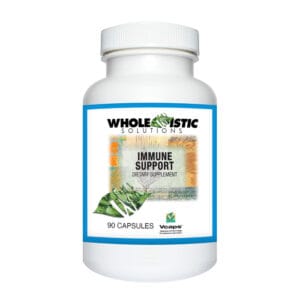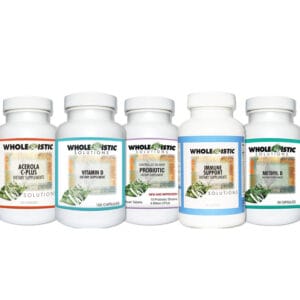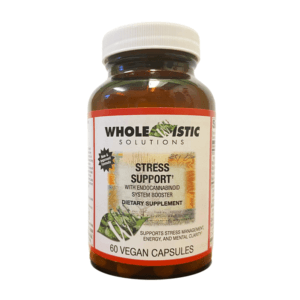Do you suffer from pain and inflammation due to injury, aging, overuse, or surgery?
Inflammation is the body’s natural protective response to trauma, but it produces pain and delays healing. To combat pain, people often take aspirin or anti-inflammatory drugs. These medications may control pain and inflammation, but they can also inhibit healing and damage the stomach, liver and kidneys.
There is a better, natural solution with no harmful side effects!
What are Proteolytic Enzymes?
Proteolytic enzymes work to clean the bloodstream and soft tissues and promote healthy digestion by breaking down harmful proteins. Enzymes are proteins themselves, but their function is speed up chemical reactions within the body. Normally there are tens of thousands of enzymatic reactions occurring in the body at once, all working to sustain life. Although there are thousands of enzymes, only a small subset of those are proteolytic enzymes, and their function is to improve all metabolic facets in the body, ranging anywhere liver function to immune support. These microscopic enzymes are found in a variety of foods as well as supplements. A large portion of proteolytic enzymes are produced by the body itself during the digestion process.
How do Proteolytic Enzymes Work?
Proteolytic enzymes digest protein which reduces inflammation and increases circulation at the site of injury so that recovery of damaged tissues can begin quickly. The practice of treating wounds and pain with these enzymes dates back to ancient times. More recently, clinical studies on proteolytic enzymes have documented their ability to reduce swelling, bruising, pain and healing time following surgical procedures and injuries. Each type of proteolytic enzyme has particular functions to assist in chemical reactions, but in a broad sense they work by breaking down harmful proteins that may cause illness, allergies, or impede healing of wounds and injuries. They do this by breaking down the defense mechanisms that dangerous cells and proteins have that would ultimately cause harm to your body. These enzymes often work by breaking down large circulating immune complexes that are taken into the body via foods like wheat, corn, dairy, and soy that the body may recognize as allergens. By doing this, proteolytic enzymes make up for any dietary issues that a person may have, and then the by products are filtered by the lymphatic system and kidneys. Proteolytic enzymes, also called proteases, work by breaking peptide bonds in different ways.
Proteolytic Enzymes Benefits and Uses:
Arthritis/Joints: The anti-inflammatory and analgesic properties of proteolytic enzymes make it a safe alternative to other medications designed to treat arthritis and joint pain. Its first recorded use in a 1964 study showed that proteases are effective in reducing pain and inflammation caused by both rheumatoid arthritis and osteoarthritis. Numerous subsequent studies confirm these results, particularly studies that examine arthritis in the knee and shoulder joints. These studies were performed to determine the mechanism by which bromelain works to treat arthritis. A 1988 study showed that proteolytic enzymes reduce edema and pain in the joints, which can provide relief for patients with arthritis.
Inflammation: Early studies from the 1960’s show that proteolytic enzymes can reduce inflammation and swelling caused by edema proceeding injuries, minor procedures, and dental surgery. Proteolytic enzymes’ analgesic properties lend themselves to be used as an anti-inflammatory medication, and several studies support this use. In a 1981 study, edema was induced in the hind leg of mice, and an oral treatment of protease showed a decrease in swelling. Proteases given to mice in a 2008 study also showed reduced inflammation by reducing the migration of neutrophil (a type of white blood cell) to the inflamed area by 50-85%. A study performed in 1988 showed that one mechanism by which proteolytic enzymes possibly work to reduce inflammation is by producing bradykinin, a peptide that causes blood vessels to dilate, blood pressure to fall, and in turn reduces inflammation. Another proteolytic enzyme proved to reduce inflammation in the lungs in patients with chronic bronchitis. This study performed in 1993 worked by giving patients 90 mg of proteolytic enzymes a day and then resulted in patients not only having reduced inflammation, but less mucus build-up as well.
Pain: Proteolytic Enzymes’ effectiveness in treating inflammation caused by numerous conditions indirectly makes it an effective anti-pain treatment. Even though most research performed is not necessarily looking to treat pain alone, all studies regarding inflammation can be linked to a decrease in the associated pain as well. A proteolytic enzyme was specifically reported in a 1996 study on 40 people to reduce pain, but again that pain was associated with a condition called thrombophlebitis that causes inflammation.
Heart Attack: An early study from 1972 with proteolytics showed that they can promote healthy blood viscosity and platelet aggregation. Since then, a study on rats was performed in 2008 where rats were injected with a 10 mg/kg proteolytic solution twice a day for fifteen days in a row. Following the treatment, the rats had improved left heart ventricle function and increased aortic flow, which left the researchers to conclude that a proteolytic treatment may be a possible cardioprotective therapy.
Blood Pressure: A study performed in 2012 showed that the enzyme nattokinase acts as an ACE-inhibitor which can lower blood pressure by producing a protease enzyme called subtilisin. A larger study performed in 2008 on 86 human participants that ranged from 20 – 80 years old treated high blood pressure using a nattokinase treatment. The experimental group showed significant improvements in both systolic blood pressure and diastolic blood pressure in comparison to the placebo group, which led the researchers to conclude that nattokinase may be used to treat hypertension.
Alzheimer’s Disease: A study performed in Taiwan in 2009 showed that the enzyme nattokinase may prevent the onset of Alzheimer’s disease. The process behind this is that nattokinase can break up amyloid fibrils, a type of peptide protein that can build up in the brain and cause cognitive damage that would lead to Alzheimer’s.
Cancer: Proteolytic enzyme therapy for cancer patients has shown to work in numerous experimental studies and clinical trials. In one study conducted in 2008, enzyme therapy given to patients suffering from breast cancer, colorectal cancer, and plasmacytoma improved the symptoms of nausea, gastrointestinal complaints, fatigue, weight loss, and restlessness caused by the tumors and alternate cancer therapies as well. Those patients suffering from plasmacytoma that were given proteolytic enzymatic treatments showed an increase in the response rates, the duration of remissions, and the overall survival times. Overall, the therapy seemed to stabilize the quality of life for cancer patients. A study performed in 1994 explains why proteolytic enzymatic treatment is effective in treating cancer; certain proteolytic enzymes produce tumor necrosis factor-alpha (TNF-alpha), interleukin-1-beta (IL-1 beta), and interleukin-6 (IL-6), which all aid in resisting cancer cells. Another study performed in 2008 on mice showed that proteolytic treatment blocks the CD128 chemokine receptor which in turn can inhibit breast cancer stem cells from developing.
Osteoporosis: Proteolytic enzymes in combination with other experimental treatments was shown in a 2014 study to decrease bone fractures and increase bone density after one year of treatment. Although this treatment is relatively new, researchers are already regarding it as a revolutionizing treatment for the management of osteoporosis. Further research on osteoporosis on post-menopausal women shows that proteolytic enzymes reverse apoptosis, also known as programmed cell death, which allows new bone formation to occur.
Fibromyalgia: The pain associated with fibromyalgia is caused by a buildup of fibrin, and several studies show that proteolytic enzymes are capable of breaking down fibrins. A study published in 1969 showed that the enzymes destroyed a fibrin stabilizing factor in an experimental study.
IBS (Irritable Bowel Syndrome): A 2007 study shows that patients with IBS release excess proteases trypsin and tryptase, making the patient more sensitive to pain, and those proteases can directly stimulate sensory neurons in the gut. However, two more studies performed in 1999 and 2011 showed that taking an oral proteolytic supplement reduced gas, bloating, and abdominal pain in IBS patients.
Allergies: In 1997 a study was performed on guinea pigs to test the effects of proteases on allergic responses. The results showed that those animals given the treatment had heightened antibody responses to other enzymes that would normally cause allergies compared to the control group. The idea behind why proteolytic enzymes work to treat allergies is simple. Allergies are caused by the body’s reaction to particular proteins, and since proteolytic enzymes work to break down proteins, they should theoretically be able to break down proteins that cause allergies.
Acid Reflux: Proteolytic enzymes may prevent acid reflux by attacking the root of the cause: the digestive system. They report that acid reflux can often be caused by poorly digested foods, and proteolytic enzymes aid in the digestion by breaking down those food proteins.
Asthma: In a 2005 study, healthy non-smoking adults with asthma were given a protease treatment, and those given the treatment were shown to have more enzymatic activity in the saliva and mucous than those not given the treatment. The rationale behind this is that many cases of asthma are characterized by inflammation and remodeling of the airways, and previous research shows that proteases have an active role in those issues.
Shingles: A study performed in 1995 had two groups of 96 people that were given either a standard shingles treatment or a proteolytic enzyme treatment over the course of 14 days. While both groups showed an improvement in treating the initial outbreak of shingles, the group given the enzyme treatment experienced fewer side effects. Another study published the same year on 90 people over a 7-day period, and that study had similar results. They also reported that in addition to experiencing fewer side effects, enzymatic treatment is less costly to the patient than standard treatment options. Proteolytic enzymes’ anti-inflammatory and immune-protective properties explains how it is able to combat the virus, Herpes zoster, which causes shingles.
Endometriosis: This condition occurs when there are dysfunctions or changes in proteolytic enzymes, cytokines, inflammatory molecules, and vascularization during the normal ovulation cycle, as summarized by a large scientific review published in 2014. Because enzymes are one of the major factors in maintaining a healthy female reproductive system, many herbalists and holistic care practitioners suggest a proteolytic enzyme supplement to help treat or prevent the onset of endometriosis. While a regulated enzymatic treatment is not available, anecdotal evidence reported by customers supports this treatment.
Diverticulitis: Since many proteolytic enzymes have anti-inflammatory properties, it makes sense that some use it to treat diverticulitis, a condition marked by inflammation and pain associated with the colon and large intestine. Furthermore, some may think that an imbalance in enzymes may be the cause of diverticulitis. However, a study published in 1969 showed that a healthy colon sample and a sample with diverticulitis had similar enzymatic activity. Nonetheless, many holistic and naturopathic care givens suggest a protease supplement to treat diverticulitis.
Candida: Yeast infections are caused by bacteria, and the proteins in that bacteria can be broken down by proteolytic enzymes. Several case studies published by naturopathic practices show evidence that a proteolytic enzyme formula can successfully treat candida.
Blood Clots: A Czech study published in 1995 suggests that proteolytic enzyme therapy can potentially dissolve blood clots as well as strengthen the arterial walls and improve the quality of blood itself. A study published the following year on proteases showed that the enzymes help to treat thrombophlebitis, a condition characterized by pain and inflammation in the veins which can lead to serious blood clots. In this study, 40 patients were administered 30 mg tablets three times per day over the course of 14 days, and by the end of the trial, symptoms reduced by over 60% in most cases and there were no adverse reactions to the treatment.
Lyme Disease: There is no current scientific research on the effects of a proteolytic enzyme therapy on the treatment of Lyme Disease. However, supplements targeted to treat this condition are available, and testimonies shown on those companies’ websites as well as Lyme Disease related anecdotal evidence claim that an enzymatic treatment is more effective than antibiotic treatments in staving off the symptoms of Lyme Disease.
Proteolytic Plus is a blend of 9 proteolytic enzymes to insure maximum absorption and effectiveness:
- Bromelain
- Papain
- Acid stable Protease
- Protease 4.5
- Protease 6.0
- Neutral Bacterial Protease
- Peptidase DPP-IV
- Serratiopeptidase
- Nattokinase
In addition to proteolytic enzymes, other important ingredients and their benefits include:
- Peppermint Leaf – increases bile flow and aids digestion by breaking down fats and reducing bad cholesterol.
- Beet Root – improves blood flow, lowers blood pressure, and increases exercise performance.
- Aloe Vera Leaf Powder – assists with wound healing, skin conditions, arthritis pain, blood sugar regulation, and oxidative stress.
Dosage: With a good diet rich in organic and unprocessed foods, you can take in all the proteolytic enzymes you need. However, this is seldom the case for most people and supplementation is necessary. For maintenance, take 1 Proteolytic Plus twice a day. if you are experiencing pain or disease, dosage should be doubled or even tripled. If going through a detoxification process, the standard dosage should be doubled, or in some cases tripled or quadrupled until the effects are felt. For athletes or anyone undergoing regular intense exercise, a tripled or quadrupled dosage is also recommended. Doses should be taken between meals away from food.

